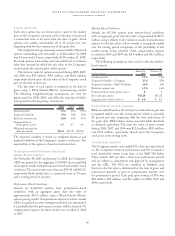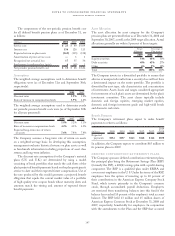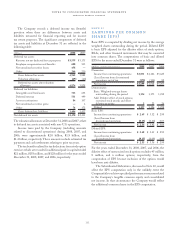American Express 2008 Annual Report Download - page 103
Download and view the complete annual report
Please find page 103 of the 2008 American Express annual report below. You can navigate through the pages in the report by either clicking on the pages listed below, or by using the keyword search tool below to find specific information within the annual report.
notes to consolidated financial statements
american express company
101
Interest-Only Strip
The interest-only strip is also recorded at fair value on the
Consolidated Balance Sheets, with gains and losses recognized
in the Consolidated Statements of Income. Refer to Note 6 for
additional information regarding the interest-only strip.
loans
For the Company’s loans, the principal market is assumed
to be the securitization market, and the Company uses the
hypothetical securitization price to determine the fair value
of the portfolio. The securitization price is determined from
the assumed proceeds of the hypothetical securitization in the
current market, adjusted for securitization uncertainties such as
the market conditions and liquidity.
financial instrument liabilities
for which carrying values equal or
approximate fair value
Financial liabilities for which carrying values equal or
approximate fair values include accrued interest, customer
deposits, Travelers Cheques outstanding, short-term
borrowings, and certain other liabilities. For these liabilities,
the carrying values approximate fair value because these are
short-term in duration, variable rate in nature, or have no
defined maturity.
long-term debt
For long-term debt, fair value is estimated using either quoted
market prices or discounted cash flows based on the Company’s
current borrowing rates for similar types of borrowing. For
variable-rate long-term debt that reprices within one year, fair
value approximates carrying value.
Refer to Note 15 for discussion of carrying and fair value
information regarding guarantees.
note 18
significant credit
concentrations
Concentrations of credit risk exist when changes in economic,
industry or geographic factors similarly affect groups of
counterparties whose aggregate credit exposure is material
in relation to American Express’ total credit exposure. The
Company’s customers operate in diverse industries, economic
sectors and geographic regions.
The following table details the Company’s maximum credit
exposure by category, including the credit exposure associated
with derivative financial instruments, at December 31:
(Billions, except percentages) 2008 2007
On-balance sheet:
Individuals(a) $ 68 $ 85
Financial institutions(b) 24 11
U.S. Government and agencies(c) 11 12
All other(d) 14 14
Total on-balance sheet(e) $117 $122
Unused lines-of-credit-individuals(f) $253 $258
(a) Individuals primarily include cardmember loans and receivables.
(b) Financial institutions primarily include debt obligations of banks, broker-
dealers, insurance companies and savings and loan associations.
(c) U.S. Government and agencies represent debt obligations of the U.S.
Government and its agencies, states and municipalities, and government
sponsored entities.
(d) All other primarily includes cardmember receivables from other corporate
institutions.
(e) Certain distinctions between categories require management judgment.
(f) Because charge card products have no preset spending limit, the associated
credit limit on cardmember receivables is not quantifiable. Therefore, the
quantified unused line-of-credit amounts only include the approximate
credit line available on cardmember loans (including both for on-balance
sheet loans and loans previously securitized).
At December 31, 2008, the Company’s most significant
concentration of credit risk was with individuals, including
cardmember receivables and loans. These amounts are generally
advanced on an unsecured basis. However, the Company reviews
each potential customer’s credit application and evaluates
the applicant’s financial history and ability and willingness
to repay. The Company also considers credit performance by
customer tenure, industry, and geographic location in managing
credit exposure. The following table details the Company’s
cardmember lending and receivables exposure (including
unused lines-of-credit on cardmember lending) in the United
States and International, at December 31:
(Billions, except percentages) 2008 2007
On-balance sheet:
United States $ 56 $ 71
International 19 24
On-balance sheet(a) $ 75 $ 95
Unused lines-of-credit-individuals:
United States $211 $210
International 42 48
Total $253 $258
(a) Represents cardmember loans to individuals as well as receivables from
individuals and corporate institutions as discussed in footnotes (a) and (d)
from the previous table.
























